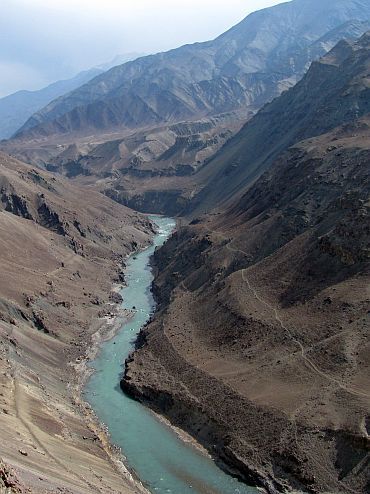 Despite desperate calls from many quarters in India for withdrawing the Indus Waters Treaty with Pakistan following the September 18 terrorist strike in Uri, it seems that the decades-old treaty between the two countries would survive the threat.
Despite desperate calls from many quarters in India for withdrawing the Indus Waters Treaty with Pakistan following the September 18 terrorist strike in Uri, it seems that the decades-old treaty between the two countries would survive the threat.
But, experts say the treaty needs a review to address the ongoing and the likely impact of climate change on river-flow. Athar Parvaiz reports.
Not political tensions, but the impact of climate change on the availability of water in river systems like the Indus basin actually call for reviewing water-sharing treaties, say experts.
India and Pakistan are currently embroiled in a face-off over the 1960 Indus Water Treaty which they had signed after eight years of mediation by the World Bank.
Under the treaty, Pakistan was allocated the waters of the Indus and its westward flowing tributaries, the Jhelum and Chenab, while India was given exclusive rights over the eastern rivers -- Ravi, Beas and Sutlej.
The Indus river rises in south-western Tibet and flows northwest through the Himalayas before meandering via Jammu and Kashmir into Pakistan. Around 39 per cent of the basin is in India and over 50 per cent in Pakistan while remaining is in China and Afghanistan.
For the past two weeks, the two countries have exchanged virtual threats over the withdrawal of Indus waters treaty soon after terrorists attacked an army base in Kashmir near the Line of Control.
However, citing different reasons, hardly any expert has agreed that India and Pakistan can seek a review of Indus waters treaty on grounds other than those relating to climatic factors.
The Indus water treaty was signed without considering the impact of climate change on water-flow in the future. Growing cooperation among countries for dealing with the impact of climate change might make a review of water treaties possible.
Though enough scientific research has not been carried out on Himalayan glaciers which feed the Indus basin, experts agree that climate change poses a serious challenge to glaciers which are sometimes termed as water towers of the world.
Also, sub-regional research on Himalayan glaciers has highlighted the likely impact of climate change on glaciers and stream-flow.
According to a paper, ‘Recent Glacier Changes in the Kashmir Alpine Himalayas’, published in Geocarto International in January 2016, nine benchmark glaciers in Kashmir Himalayas, whose data from 1980-2013 was studied, have shrunk by 17 per cent.
The paper says that annual air temperature showed a significant increasing trend while a slight but insignificant decrease in precipitation was also observed during the studied period.
Annual air temperature showed a significant increasing trend and a slight but insignificant decrease in precipitation was observed during the period. It is evident that, in the same climatic regime, varying topography plays a key role in determining the glacier changes. It is believed that the observed changes in the glacier geometry and dynamics, if continued, shall have an adverse effect on the streamflows, water supplies and other dependent sectors in the region.
‘It is believed that the observed changes in the glacier geometry and dynamics, if continued, shall have an adverse effect on the stream-flows, water supplies and other dependent sectors in the region,’ the paper says. These glaciers provide snowmelt to the Jhelum, one of the three rivers of the Indus basin which flow to Pakistan.
Leading author of the paper, Shakil Romshoo, said that any revision of the water treaties governing the trans-boundary sharing of waters should be guided by scientific knowledge rather than the political considerations.
“As far as the IWT and other such treaties are concerned, which were signed a long time back, climate change, environmental flows and a few other important aspects were not considered when the treaties were signed,” Romshoo said.
“So, the revision of any treaty should be undertaken to incorporate these new issues that have significantly impacted the water resources availability and distribution so that the water sharing is accomplished in a more realistic and cooperative manner without killing the soul and spirit of the existing treaties.”
Ashok Swain, director, Research School for Water Cooperation, Uppsala University, Sweden, said that the whole Indus basin needs to be looked at as a single unit for the best possible use of the river water. According to him, increasing demand and climate change related uncertainties need to be taken into consideration.
“I have been arguing and writing that the Indus Waters Treaty has outlived its utility and both India and Pakistan should work towards revising the treaty. They also need to bring Afghanistan and China to the ambit of the new treaty,” Swain said.
“Moreover, the 1960 agreement is not a water agreement, it is a partition agreement: three rivers to India, three rivers to Pakistan. That has not only reduced the possibility of successful water development schemes, but has also failed to contribute to improve bilateral relationship in other areas.”
A K Gosain of Indian Institute of Technology-Delhi opined that any treaty on water cannot afford to be static any more on account of various issues such as pressures of increasing demands and also on account of the implications of climate change.
“The societies of the river basins shall be required to cope with the implications of climate change on water resources. Trans-boundary countries can be better off tackling these issues collectively,” Gosain said.
“Things around water resources are so complex that invariably they were never completely understood when the treaties were formulated. As the scientific knowledge becomes better revisions might be needed and renegotiations may be inevitable.”











 © 2025
© 2025